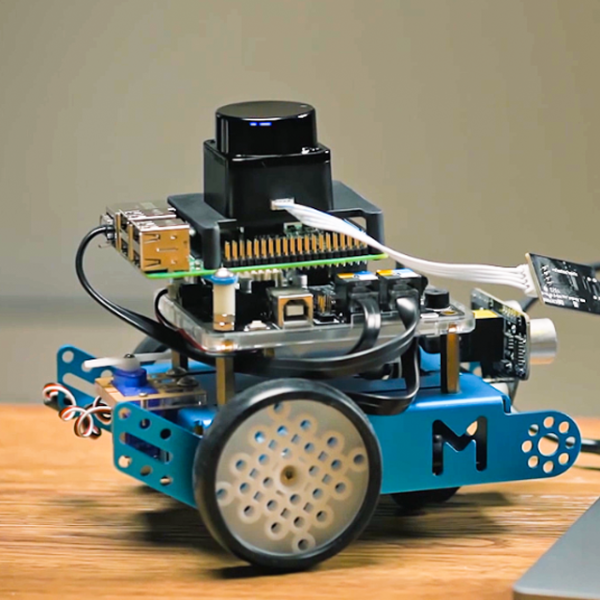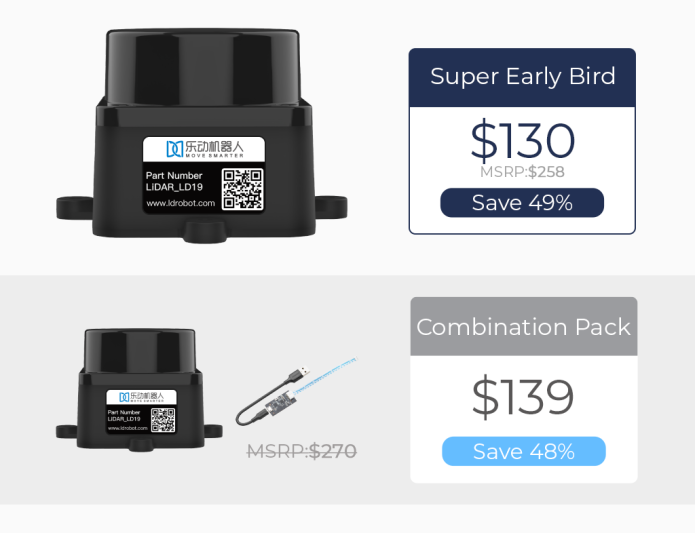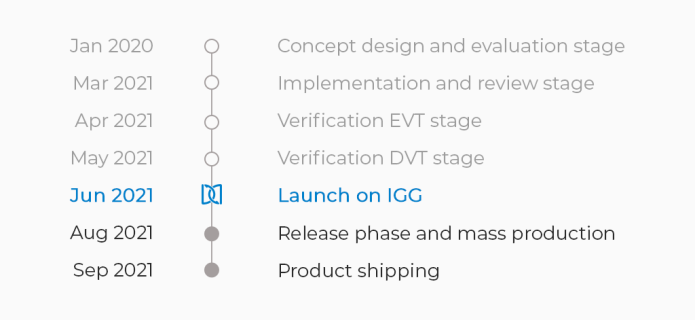
Ultra-Small Laser Sensor with 360° Sensing Capabilities that is small enough to fit in any appliance

Recently, LiDAR sensors have been widely used in various industries such as automobile, archaeology, geography, agriculture, and more. The main purpose is for making high-resolution maps.
The most common example, autonomous cars, also use LiDAR for their control and navigation systems. Unfortunately, the price of highly accurate LiDAR sensors is very high, often thousands of dollars which puts this useful technology out of reach for many.
It’s time for us, the LDROBOT Group, to disrupt this industry and make LiDAR accessible to everyone!


LD-AIR LiDAR offers high accuracy sensing capability TOF LiDAR sensors to everyone at an affordable price starting from $130.
Using advanced technology, the TOF sensor in LD-AIR LiDAR is a highly accurate with 360° scanning range for precise scanning results every time.

- Time of Flight Measurement

Compared to other traditional laser scanners, LD-AIR LiDAR utilizes the Time of Flight technique to detect distance precisely within a 12 meters radius range. It emits an infrared laser forward and then the laser is reflected back into the single-photon receiving unit after encountering the target object. The gap between the time of laser emitting and receiving is the time of flight.
- 360° Omnidirectional Scanning Range

With its 360° rotation range, LD-AIR LiDAR can sense the surrounding environment with no dead corners to actualize obstacle detection and autonomously map any area.
- Collects Samples 4500 Times per Second

For sample frequency, it can measure up to 4500 samples of laser ranging per second with high rotation speed which greatly increases the mapping speed.

- DIY Autonomous Robot

LD-AIR LiDAR takes your creative robot projects such as drones and self-driving cars to the next level, making them smarter and more useful. It can be practically used to sense the environment and avoid obstacles. By detecting the absolute positions of objects, it enables your drone to do autonomous mapping and navigation.
- Software Support

For creative makers, you can use LD-AIR LiDAR in your projects with software development kits like Raspberry Pi, Arduino, Javascript, and other specialized robotic operating systems.
- Digital Art – Multimedia Interactive Projection

Using a whiteboard or poster to present an idea or communicate with an audience is typical. But with LD-AIR LiDAR, it can be done better. LD-AIR LiDAR allows you to create a cutting-edge multimedia interactive projection on the wall, ground, large screen, or desktop which can add interest to the content and strengthen learning and communication to enhance the overall experience.
- Algorithm Verification

LD-AIR LiDAR also can be used for conducting experiments that help to test the validation of an algorithm for specific purposes.
- Born To Be Practical

LD-AIR LiDAR is built to serve business and research purposes that require robot navigation and obstacle avoidance. If you are a robot developer or robotic engineering researcher, this essential component makes your robots more useful and intelligent at an affordable price.
- Robot ROS teaching and research

- Home Security

Like a motion detector, LD-AIR LiDAR is able to detect motion changes in a room with high sensitivity. Because of this ability, you can use it to create a home security system that will sense anything interrupting a particular area. It can sense when someone walks through a doorway or tries to move the objects in a room, and can be used to track people’s movement.
- Environmental Scan and 3D Mapping

- Vacuum Robots


Acting as ‘the eyes’ of vacuum robots, LD-AIR LiDAR is designed to be invisible and it is small enough to be completely contained within the body of the robot without any external housing. This way, vacuum robots can remain low-profile to move freely under and around furniture more easily.
- Service Robots

Based on its functions of autonomous mapping and obstacle avoidance, LD-AIR LiDAR can be applied to the design of working service robots for tasks such as route setting and automatic responsive behaviors. Its mission is to make your robots more intelligent.

Equipped with a brushless motor, LD-AIR LiDAR reduces the mechanical friction while operating so it runs more smoothly without loud noises. More importantly, this brushless motor provides an extended lifespan, reaching more than 10000+ hours, which is 10 times longer than other laser sensors. Therefore, it requires low maintenance and fewer replacements for any applications equipped with LD-AIR LiDAR.

- Water & Dust Proof

The new bottom case design empowers LD-AIR LiDAR with water and dust resistance that allows it to run perfectly in any condition (*The surface needs to be maintained clean in actual use.).
- Outdoor And Indoor Adaptability

With anti-ambient light 30 Klux resistance, it can always maintain its high-accuracy performance under any circumstances with no limitations.

LD-AIR LiDAR is a Ready-To-Use compliant laser sensor that is small and versatile enough to fit in any appliance.
- Ultra-thin and Ultra-light





Certified FDA Class 1 Laser Safety Standard, LD-AIR LiDAR adopts the low-power infrared laser light as its light source and drives it by using a modulated pulse, ensuring both effectiveness and safety. Creating no harm to the eyes of humans and pets.













LDROBOT is a high-tech enterprise focusing on the research and development, production and global sales of robotics, artificial intelligence and related core technologies.
Based on independent research, development and innovation, the company builds the “central nervous system” of mobile robots through technologies such as environment reconstruction and perception, map construction and autonomous navigation, dynamic object recognition, machine learning, motion control, cloud computing and cloud services.
Currently, LDROBOT has more than 200 core intellectual property rights in AI and robotics technologies, with nearly 200 patents and more than 20 software applications, along with a global IP system covering the core fields of robot environment reconstruction and recognition, machine vision, deep learning and artificial intelligence.


